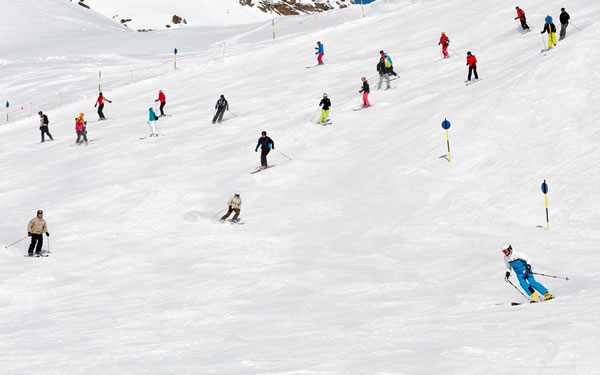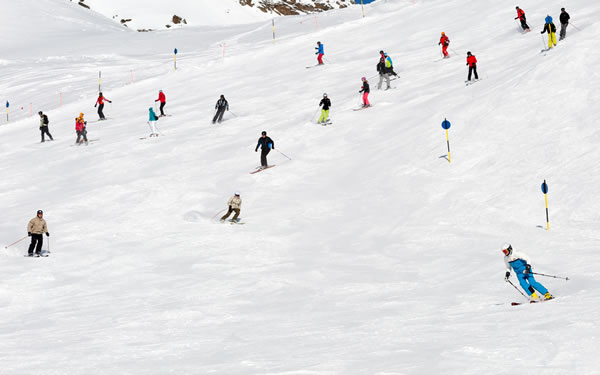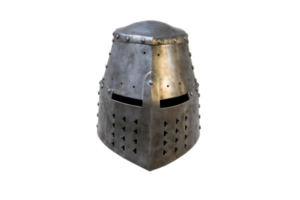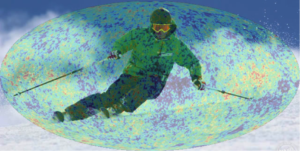Expert skiers don’t worry about falling. But they do worry about collision. A lot.
As in, all the time.
Collisions hurt. Falling down a steep mogul slope, while terrifying at the time, mostly injures one’s pride; colliding with another speeding skier will dislocate every bone in the body.
The modern panacea for collision mitigation is the helmet. For puttering-along impacts, the modern ski helmet does a fine job of protecting the surface it covers.
As for collision avoidance – vastly preferable to mitigation – this observer of the ski scene finds that the virtual omnipresence of helmets has done nothing to expand skiers’ situational awareness. I contend that helmets, minus situational awareness, make collisions more likely and when they occur more likely to be more serious than if their use were banned.
Here’s why.
First, there’s the “safety bubble” effect. Donning of the helmet, too often naively revered as the ultimate protective device, imparts a sense of invulnerability, as though armor like a medieval knight’s now covered the entire body.
“The magical helmet will protect us from all harm.”
But the fact is that helmets don’t make you a safer skier, any more than having 4-wheel drive makes it it safer to drive on black ice.
Perhaps more insidious than the illusion of indestructibility is a helmet’s tendency not only to fix the skier’s vision forward, but to hold it there, as if in an invisible brace. Slip on the goggles, and you’re in a little capsule, your vision locked in a narrow scope. Many helmeted skiers aren’t looking at a lane any wider than a bobsled track and if the track looks clear, all is well.
If skiers’ peripheral vision is impaired and they don’t feel comfortable turning their necks, just how much open slope is actually being investigated for flying objects?
The solution lies in expanding one’s sphere of awareness. Keep your helmet on, but change the way you ski, or at least the way you change lanes.
The first principle of situational awareness is that anyone might cross your line of travel at any time. You can be tootling along a cat-track, gazing up at the snowy tree tops, when someone emerges from the woods as if from nowhere and ends your reverie in a jarring heartbeat. This actually happened to – and ended the skiing career of – the legendary Stein Eriksen.
The second principle is always to have your head on a swivel. Not just when crossing another trail or passing below a rock that’s a frequent launch point, but all the time.
If you’re going to cross the equivalent of more than one lane of traffic, you need to know not just what’s in front of you, but more importantly, who’s behind you. From your perspective, you’re just sidling across hill to find some softer snow; to the skier already in that lane and charging, you’re a sudden obstacle that’s going to be lucky to avoid extinction.
The icon of situational awareness is the fighter pilot. He, too, wears a helmet and goggles, but he’s well aware that in the fluidity of air, an enemy can approach from any direction. His sphere of awareness has to be a complete globe around his plane; skiers need to think the same way.
A skier’s vision isn’t the only sensory system that needs to be operating at full capacity. Hearing is handy, which is another demerit for helmet users who complement the physical cocoon with an auditory filter that eliminates hearing as an early warning device. These skiers couldn’t hear an overtaking locomotive.
Any situation that reduces a skier’s scope of awareness spells trouble. The jibber who’s fixated on a kicker or terrain feature blocks out all distractions – like other skiers – as he psychs up for lift-off. The back-of-the-pack friend, fearful of falling too far behind, glues his eyeballs on the last parka still in sight. He might as well be hypnotized.
Here’s a little-known secret: one of the characteristics of truly great skiers that separates them from the merely competent is their nearly infinite sphere of awareness. Before they even push off, they have a mental catalog of who is doing what and where around them, estimating where everyone on this map will be in 20 or 30 seconds. Only when they know exactly how to avoid all the potential interference will they commit to their line.
Be particularly aware when traversing across the fall line or entering a new trail, but it’s wisest to treat every open space ahead of you as a potential intersection of two flying bodies.
We highlight this perpetual truth now because many of us are skiing on limited, early season conditions. Every skier ability, every skier style, every skier with no style whatsoever, will all be sharing the same space. The only way to survive in this moving menagerie is to turn your situational awareness meter to maximum. When you reach the point of sensory overload, get off the hill. This is not the time to ruin the rest of the season, for you or anyone else you might suddenly meet.
Allow me to be more succinct (as I’m running out of space and time): don’t just watch where you’re going, watch where everyone around you is going.
And please, if you don’t want to end up learning first-hand about reconstructive surgery, no selfie poles! Consider this: the people you hit while filming yourself will include you.



 Super-coach Mike Rogan Skis the Known Universe!
Super-coach Mike Rogan Skis the Known Universe!